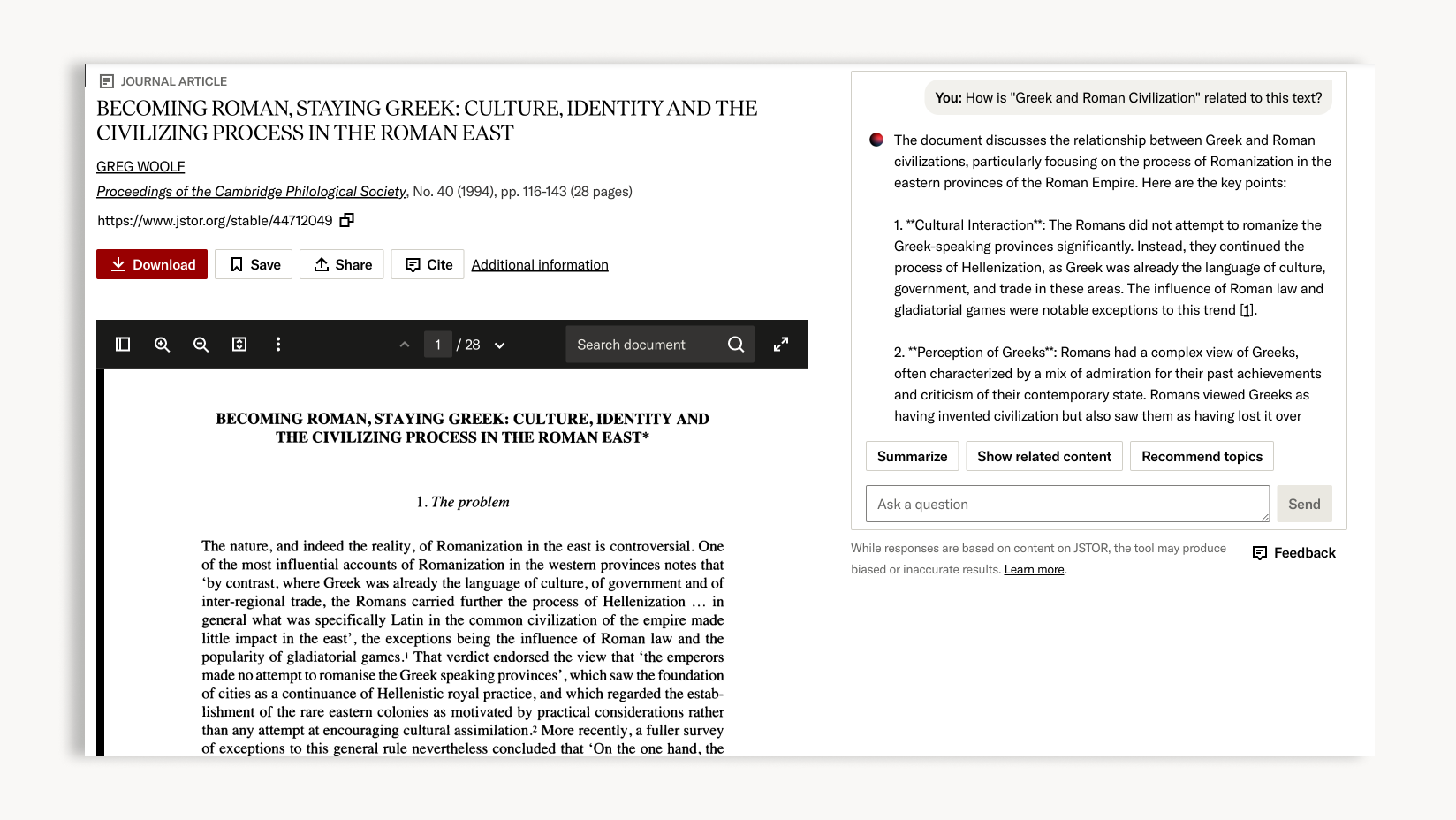Research involves more than direct translation, requiring adaptation to new cultural norms. JSTOR’s AI research tool promotes equity by giving students from various backgrounds a platform to explore and develop their perspectives.
Electronic resources librarian and student finds AI and other emerging technologies essential to broadly accessible research
Yuimi Hlasten, E-resource and Scholarly Communication Librarian at Denison University, is passionate about emerging resources and technologies for university students and faculty. Beyond her role as a librarian, she has participated in a panel discussion at a NISO Plus conference, and has also presented at the Electronic Resources and Libraries and Online Learning Consortium conferences, among others.
Her extensive experience with academic resources puts her in the forefront of trialing innovations that benefit students and faculty at her institution. However, what sets her perspective apart is her experience with JSTOR’s AI research tool, not only as a librarian, but also as an international student. While she leverages her expertise to introduce resources to the Denison University community, she has also personally benefited from the tool’s capabilities in her own coursework.
A dual perspective on academic tools and resources

Roman. Marble portrait bust of a woman. Marble. ca. 193–211 CE. Part of Open: The Metropolitan Museum of Art.
As a librarian dedicated to electronic resources and digital collections, Yuimi’s responsibilities include managing library resources and supporting student and faculty research. This means ensuring access and promoting resources that offer key benefits to Denison’s unique student and faculty populations. Effective resource management means having a strong grasp on the university community’s needs, keeping in mind the nature of the student population and the manner of their research.
An excellent means of understanding the needs of students is to be a student—precisely the position that Yuimi recently found herself in. She returned to school to obtain a bachelor’s degree in computer science after previously studying in both her native Japan and at the University of Pittsburgh. Part of her coursework for this degree was a general education requirement, which involved taking a course in Greek and Roman Civilization.
Courses in the humanities (encompassing subjects like history, philosophy, language, and more) come with unique challenges in combing through scholarly resources for information. Often, humanities-focused academic articles do not include abstracts, meaning that determining their relevance to a research topic requires reading quite a way into each of them. Yuimi, who was juggling her studies and working a full-time job as a librarian, found this part of the research process to be a significant roadblock. She said, “As a librarian, I’m good at finding papers, but… I’d often waste time reading papers that didn’t fit my focus.” She would spend as many as fifteen minutes reading articles, only to realize they were irrelevant.
“As a librarian, I’m good at finding papers, but… I’d often waste time reading papers that didn’t fit my focus… I typically cited 15 sources per week… This would have been absolutely impossible as a part-time student without [the research tool].”

From library advocate to student user: Trying out JSTOR’s AI research tool
Having been introduced to JSTOR’s AI research tool during the 2023 NISO Plus conference, Yuimi decided to test its capabilities while doing research for her Greek and Roman Civilization class. The class required weekly writing assignments, driving her to explore topics such as the social status of women and slaves, and the types of democracy in ancient Greece and Rome.
Yuimi used the conversational tool to filter through resources to assess their relevance, and to quickly fact-check and cite resources. She was able to ask the tool specific questions to easily filter through resources, such as “Does this paper compare Roman women to those in Asian civilizations?” She noted that Google and library searches lack this capability, and that interrogating each resource using the tool made for better- focused research time.
With this new addition to her research process, Yuimi was able to take what she called a “divide and conquer” approach to her research. She was able to gather, synthesize, and present her findings more optimally. Reflecting on her experience, Yuimi mentioned, “I typically cited 15 sources per week… This would have been absolutely impossible as a part-time student without [the research tool].”
A new access point for international students: Accessibility, community, and equity

Roman. Faience polyhedron inscribed with letters of the Greek alphabet. Faience. ca. 2–3 CE. Part of Open: The Metropolitan Museum of Art.
From Yuimi’s point of view, JSTOR’s AI research tool offers the chance to “help international students engage with research just as efficiently as domestic students.”
Dr. Paul A. Djupe, Director of Denison University’s Data for Political Science program, reports that international students at Denison admit to using AI at two to three times the rate of domestic students. While 18% use AI to write papers (compared to 6% of domestic students), majorities also rely on it for background research and reading summaries at double the rate of their peers. These findings suggest that, based on student disclosures, AI-powered tools are proving at least somewhat beneficial to their academic work.
Yuimi believes that tools like these can serve as equalizers by helping students overcome language barriers and adapt to academic norms in a new language.
Connecting and resonating with peers and professors doing research is crucial to a productive scholarly environment. It requires agreement on terms, familiarity with methodology, and other particulars that keep research coherent for all members of the field and beyond. This can be difficult as a second-language learner, because, according to Yuimi, “international students often have fewer domestic friends to collaborate with or network on research topics.”
Reworking ideas into a foreign language can be challenging because it requires researchers to access different versions of themselves. Students must maintain their own, unique theses while translating them into common sets of words and phrases. “For most international students, this is like performing a mental somersault for every research paper they write,” Yuimi explains.
“For most international students, this is like performing a mental somersault for every research paper they write… Since research is fundamentally about communication, every international student should take advantage of AI tools.”
Research, after all, comprises more than just direct translation. Effective communication can prove difficult for international students when developing messages meant to connect with their domestic peers. Yuimi’s suggestion is that “Since research is fundamentally about communication, every international student should take advantage of AI tools.”
Yuimi maintains that JSTOR’s AI research tool, and tools like it, can help students from various backgrounds find their inner voice. She suggests the tool can help students “engage in active conversations with every paper” they read by taking advantage of the tool’s interactivity—addressing doubts, criticisms, and other thoughts that arise—which will bring students into their own as researchers.

Librarians as advocates: Bringing advanced technologies into universities
Yuimi earned an A+ in her Greek and Roman Civilization class, which she says is partially due to the “big role” JSTOR’s AI research tool played in her studies. Combined with her extensive experience as an electronic resource librarian, Yuimi is in an excellent position to support and advocate for the tool’s use on an institutional level.
Institutions like Denison University are still learning how to best operate in the face of rapidly changing technologies, with centers like libraries working toward the articulation of best practices. Yuimi is part of Denison University’s AI Staff Collaborative cohort, who are all navigating these changes together. Groups like these facilitate a dialogue between members of an institution looking for guidance around approaches to AI and other emerging technologies. She is also a frequent attendee of conferences like the NISO conference, and “highly recommend[s] attending these events and signing up as beta testers for AI tools.”
For librarians interested in supporting international students, Yuimi encourages them
to “view AI [research] tools through the lens of social justice,” as “these tools provide disadvantaged students with a way to find their inner voice and communicate it in a manner that resonates with the society they (often uncomfortably) live in.” She also encourages librarians to collaborate with their campus’ international student office if they notice that this student population is using AI-powered tools at a higher rate than others. This way, librarians can better consider and address students’ academic challenges.
“…these tools provide disadvantaged students with a way to find their inner voice and communicate it in a manner that resonates with the society they (often uncomfortably) live in.”

Explore what’s possible with JSTOR’s AI research tool
Yuimi Hlasten’s journey exemplifies the wide impact of JSTOR’s AI research tool. Her dual perspective as a librarian and student demonstrates how this tool addresses diverse research challenges, making academic exploration more efficient and accessible.
In her advocacy, Yuimi emphasizes that tools like JSTOR’s research tool represent an important step toward equitable access to knowledge. By engaging students of all backgrounds in active and AI research, JSTOR’s tool empowers them to communicate their ideas and participate fully in scholarly conversations.
To explore the benefits of JSTOR’s AI research tool, learn more about it here. Join a community of forward-thinking educators, librarians, and students working to enhance academic accessibility and drive impactful research.